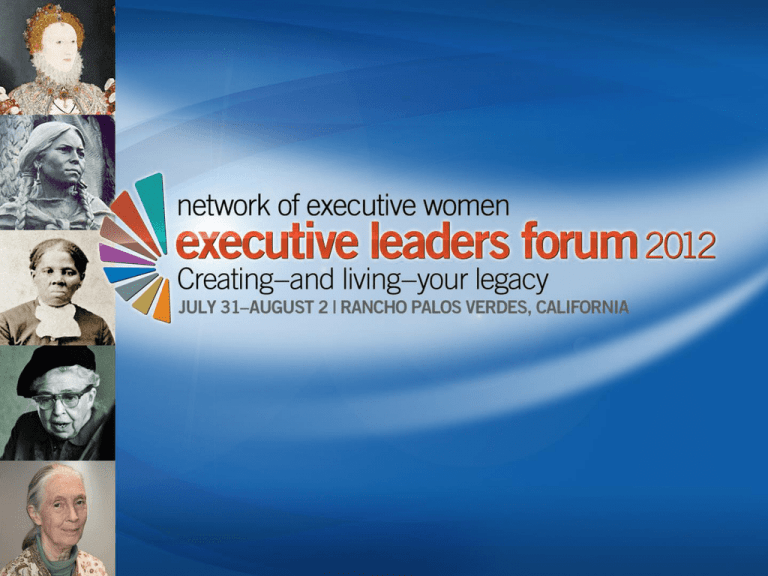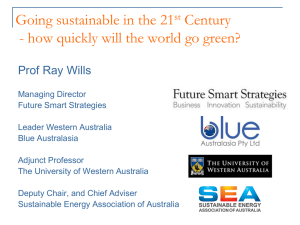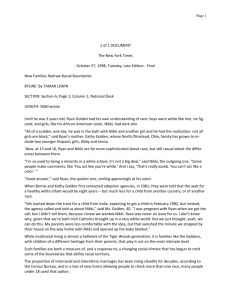Presentation - Network of Executive Women
advertisement

Diversity: Becoming a Powerful Champion for Other Women Robin J. Ely Warren Alpert Professor of Business Administration Senior Associate Dean for Culture and Community Harvard Business School Agenda • • • • The Research Panel Q&A Personal Action and Planning How I came to this topic • I am a feminist. • My first real job: worst experiences with only other professional woman. • But: relationships with my women friends my saving grace! • What gives??? • My dissertation topic. Questions we will consider today: • Why are workplace relationships among women so fraught with conflict when, for so many of us, women are our greatest sources of support? • How do our racial, ethnic, and generational differences create division and disconnection? • What can we do to better support our own and other women’s ambitions? And an invitation . . . Media Depictions: Women’s Workplace Relationships Media Depictions: Men’s Workplace Relationships Belief 1: Women just are pettier than men. • A divisive belief. Reframe: • People compete in the realms to which they have access: • Men: damage other men’s standing in the status/power hierarchy— challenge, exclude from power • Women: damage other women’s standing in the social network— gossip, exclude from . . . relationships • Both are aggressive behaviors, negative, and defensive. • Women’s “petty” behavior captures more attention and engenders more criticism. • Women are supposed to be NICE . Not supposed to want to win. • Men’s pettiness assumed to stem from rational and legitimate desire for greater status and wealth. Gender inequality and gender stereotypes create “mean girl” image of women who compete/want to win. The question is: What do we want to win? • Not in the ‘’zero sum” game of “I win, you lose.” • But in the realm of what kind of world do we want to create? • We need to recognize that, as women, we have a collective agenda. • “I think women need to come together and challenge ourselves to find our Susan B. Anthony voice. We haven’t found our collective voice.” --Trudy Bourgeois The Center for Workforce Excellence Let’s start building that agenda! Belief 2: Women in positions of power are Queen Bees. • They disassociate from and impede the progress of other women. • They want to be special. • They want to be the only one. A Contradiction for Women in Positions of Power: The “Double Bind” A Contradiction for Women in Positions of Power: The “Double Bind” Woman Leader Warm Nurturing Communal Decisive Dominant Agentic Woman = Leader Typical Research Findings Experiment: • MBA students evaluate two different versions of case of a successful woman entrepreneur (Heidi and Howard). • Asked to evaluate style, competence, likeability, whether to hire. Outcomes: • Equally competent and effective. • He’s more genuine and kind; she’s more self-promoting and power hungry. • He’s more likeable and more likely to be hired. • The more aggressive they perceived her; the more they disliked her • No effect for him. Frank Flynn and Cameron Mitchell, MBA Class experiment, Columbia Business School “Damned if we do, doomed if we don’t” • If women emulate a masculine style, people will dislike them. • If they adopt a stereotypically feminine style— warm, caring—they will be liked but not respected. Conclusion: Women trade competence for likeability. 15 Media Illustrations of the Double Bind “blunt, testy . . . sharp-tongued, and occasionally combative” - NYT The Double Bind as Distraction • Women are not more “warm, nurturing, and communal” than men. • Effective leadership is not about demonstrating “decisiveness, dominance, agency.” • To get caught up in the double bind is a distraction from leadership; it is merely useful information. Leadership is about enabling other people to bring their best selves to bear on a meaningful goal. What is your leadership about? What is your purpose? How can you enable women to join you in those goals? Women in Positions of Power: We need more of them! Low Being female is a liability: Double-binds Proportional Representation of Senior Women High Being female is indifferent/ a good thing Perceptions of senior women: • Poor role models • Act too much like men • Too sexual • Gender no basis for identification Relationships with women peers: • Not supportive • Dysfunctionally competitive Perceptions of senior women: • Great role modes • Supportive • Gender a positive basis for identification Relationships with women peers: • Supportive • Competitive, but able to stay in a relationship Belief 3: You can’t “have it all.” • The “ideal worker” – a committed professional who dedicates 24/7 to the job (really ideal?). • Millennials – ambitious, but place higher value on living personal and family values. • Successful women have paid a price for their success, are dismissive of women who choose a different path: • “I gave up so much, why should she have it all?” • “To change the rules by asking for special treatment (e.g., part-time work) reinforces gender stereotypes.” • “They just don’t understand what it takes to be a high-powered, committed professional.” Successful women don’t question the norms; younger women feel betrayed. And on the flip side . . . “When I look at [female partner], I think, ‘What kind of mother is she,’ in addition to how do I think she is as a partner. And the reason that that comes into play is that I assume she is going to apply the same standards to me as she does to herself. So if she doesn’t mind being away from her kids three or four nights a week, I’m going to assume she is going to expect that from me. And when I look at men I don’t actually think about what kind of father they are. I just think about what kind of male partners they are.” - Woman associate in a consulting firm Each group feels judged and criticized by the other. We need collectively to change the nature of work! Conclusion #1 • We cannot understand women’s workplace relationships without understanding how . . . • • • • • Gender bias Gender stereotypes Traditional work norms Cultural beliefs about “good” mothering Men’s disproportionate power . . . create divisions and disconnections among us. We need to join together and resist! Belief 4: Women face similar obstacles/opportunities on their journeys up the corporate ladder. National Survey (N=825) In-depth Interviews (N=120) White Black • I must perform better than men to be seen as competent. .15 .41 • I have women role models of my race. .40 . 17 • I feel accepted and a member of my company’s team. .81 .51 • White women more likely to believe the workplace is a meritocracy; black women more likely to see systemic obstacles in the organizational structure and culture. • White women perceive the relationship between white and black women to be better than black women perceive it to be. Differential Rates of Access to Managerial Positions Differential Impact of Affirmative Action and Diversity Practices Estimated Average Differences in Managerial Composition Due to Adoption of Affirmative Action & Diversity Practices 1971-2002 White Men White Women Black Women Black Men Proportion of Organizations 2002 1971-2002 Affirmative Action Plan Proportion in year of adoption Percent Difference due to adoption .783 -1.8%** .132 7.6%** .017 .0% .024 4.2%** .42 .63 Diversity Committee Proportion in year of adoption Percent Difference due to adoption .630 -3.0%** .230 13.9%** .014 29.8%** .020 10.0%** .05 .19 .702 -2.6%** .193 6.7%** .014 .0% .020 -10.0%** .06 .19 .690 -.3% .216 .0% .017 23.5%** .021 4.8%** .03 .11 Networking Programs Proportion in year of adoption Percent Difference due to adoption Mentoring Programs Proportion in year of adoption Percent Difference due to adoption Note: N(organizations) = 708 *p<.05;**p<.01 (two tailed test). Similarities between White and Black Women • Both groups reported a tendency to stay away from each other in social interactions. • Neither group reported a willingness to discuss their cultural differences with the other. • Both groups’ depictions of each other grounded in stereotypes that reinforce the image of women as nurturers, compromisers, and sexual manipulators. • Other groups of women of color (Dragon Lady, Geisha/China Doll, Jezebel, Sexual Firebrand) • By definition, stereotyped images erase complexity, multiplicity, and contradiction—they are not who we are. Women do not “see” each other across racial lines. Conclusion #2 • Racial/gender stereotypes and systems of gender/race inequality promote disconnection and dis-identification among women: • “Privilege” white women over women of color • Raise the specter of sexual competition for men • Reinforce contempt for/fear of women’s power HAVE WE HAD ENOUGH??!! Belief 5: To focus on our differences is divisive. • Grounded in a value on “colorblindness” • Belief that racial group membership should not be noticed or acknowledged and that race should not be discussed. • Strategy to minimize appearance of prejudice during a cross-race social interaction. • Empirically shown to be improbable. • Has become a leading institutional strategy for promoting racial equality. Consequences of Colorblind Strategy • Adopting colorblind (vs. value diversity) mindset : • Inhibits whites from reporting of overt racial injustice. • When whites avoid race during interracial interactions: • Blacks are more likely to view them as prejudiced. • They engage in less eye contact and appear less friendly. • They communicate and perform less effectively. • Strategies for dealing with race in cross-race mentoring relationships: • Direct engagement • Denial and suppression Develop shared perspectives on how to understand and address difference. Conclusion #3 • Open dialogue about how race influences women’s workplace experiences can be a path to connection. How to Become a Powerful Champion for Other Women (and to be powerfully championed) • Stop colluding! When tensions arise, see the larger picture. • Invest in developing someone different from you: • Mentors: educate yourself; develop your mentees. • Mentees: educate and develop your mentors. • Get on the same page regarding the role this difference makes to the career experiences of the mentee. • Develop a learning partner with whom to experiment having conversations across lines of difference about those differences. • Make it personal. Today’s Panel • Jenna Dudevois, Director Marketing, Kalypso • Lisbeth McNabb, CEO and Founder, w2wlink • Sandra Finley, President, League of Black Women • What can you tell us, based on your experience, about the path forward to women becoming powerful champions and supporters of other women?











